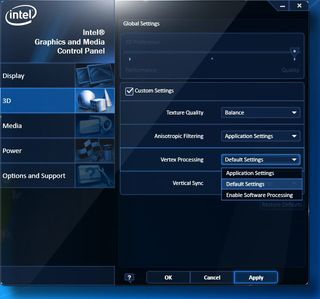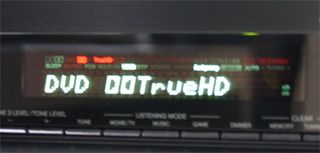Intel Core i5-661: Clarkdale Rings The Death Knell Of Core 2
New Drivers And Great Home Theater Features
Software
One area where Intel has put in significant work is its graphics driver interface. More than anything, the redesign simply modernizes the look and feel, going from a boring business to sleek home desktop motif. The company enables custom resolution settings, but aside from that, not much else is changed.


Intel HD Graphics In The Home Theater
Most of Intel’s efforts in improving its integrated graphics core are directed at the home theater experience—a field on which the company actually stands a chance. The G45 chipset already put Intel on the map by enabling multi-channel LPCM audio output over HDMI and supporting accelerated MPEG-2, H.264, and VC-1 (the trio of Blu-ray codecs) decoding.
But Clarkdale’s HD Graphics core goes a few steps further by offering dual video decode streams for picture-in-picture, dual simultaneous HDMI outputs (though we haven’t yet seen any motherboards exposing this yet), DisplayPort audio (also recently enabled on ATI’s Radeon HD 5000-series discrete boards), and lossless Dolby TrueHD/DTS-HD Master Audio bitstreaming to compatible stereo receivers.
Intel also makes it a point to mention that its HD Graphics core supports xvYCC, a color space used to expand the overall color gamut beyond RGB and YCbCr. This likely isn’t worth touting right now, though. After all, this is one of those features requiring support from every component in the chain—from source to output—and it is not supported by the Blu-ray format. Rather, it’d be one of those additions to home video taken with AVCHD-compatible camcorders. Windows 7 also supports xvYCC, and we've asked Microsoft about the possible ramifications of hardware support for this on the desktop and in games (we'll update when a response comes through).
Update: As promised, we've received word back from Microsoft on the issue of xvYCC in Windows and gaming. In essence, the Windows 7 desktop does not currently make use of xvYCC directly, although full-screen games certainly can. The use of this in games is recommended by the Games for Windows Technical Requirements in the Showcase Appendix as S.6 Support High Color. The new WDDM 1.1 driver WHQL tests include more robust testing of these High Color display modes, and almost all DirectX 10.x/11-era and most DirectX 9 Shader Model 2.0/3.0-era discrete video cards already have >8-bit DACs, so most users (certainly most, if not all, hardcore gamers) already have at least part of the High Color display hardware support.
Stay On the Cutting Edge: Get the Tom's Hardware Newsletter
Join the experts who read Tom's Hardware for the inside track on enthusiast PC tech news — and have for over 25 years. We'll send breaking news and in-depth reviews of CPUs, GPUs, AI, maker hardware and more straight to your inbox.


The most accessible feature for most home theater enthusiasts is probably going to be the ability to bitstream high-def audio formats. Intel gave us a beta build of CyberLink’s PowerDVD 9 Ultra with preliminary support for H55/H57’s protected audio/video path, enabled through the chipset’s Manageability Engine. We’ve had bad luck with Onkyo’s TX-SR507 in the past, so we fired up our 24-bit/96 kHz test disc with a bit of trepidation. But the hardware/software combination worked like a charm and the receiver was able to decode the TrueHD signal without a problem…well, almost. We did run into an issue where the system would lock up completely after four or five minutes of playback.
A couple of months back, I noted that companies like Asus and Auzentech were in trouble with their HTPC-oriented soundcards, designed specifically to enable bitstreaming. ATI’s Radeon HD 5750 and 5770 made the same technology available as a value-add. Now you can get that functionality from a simple motherboard upgrade.
Of course, if you don’t have a receiver able to decode either high-def format, you can also set PowerDVD to decode the signal itself and Intel’s chipset will still output multi-channel linear PCM to your receiver. You’ll only get 16-bit/48 kHz sound, but in truth, most Blu-ray movies employ 16-bit sound anyway.
Current page: New Drivers And Great Home Theater Features
Prev Page Intel HD Graphics: Clarkdale’s On-Package GPU Next Page H55 And H57 Chipsets-
Zoonie Well... I think that takes care of the dreaded "But can it play Crysis?" question regarding its GMA :D :P :PReply -
eklipz330 can i ask why you teased us at the end with the 4.5ghz OC but didn't include them in the benchmarks? =Reply -
cangelini xc0mmiexVideo on page 1 not working ... "This is a private video..."Reply
Fixed! Had to keep it private pre-launch :) -
I really like the improvements Larrabee brought about....not! I do like the fact they are making progress but they really need to skip ahead a few generations or buy out some other company to design a GPU for themselves.Reply
-
gkay09 ^ Many more reasons to buy AMD Phenoms II X4 in the mid-range segment...Reply
Only drawback with the AMD CPUs is the power consumption, that I feel can be brought down with slight undervolting... -
dtemple I'm looking to upgrade from my Athlon X2 @ 2.7GHz because I do more with the computer now than I did before - sometimes I'll play a game while my TV tuner is recording from my cable signal, and having more cores would help these multiple tasks run more smoothly.Reply
I was waiting until the Clarkdale-based i5 launched, thinking it would be a quad-core that was more competitively priced against the Phenom II X4, but it looks like a Phenom II X4 is my only option to get more cores for less money.
The only good news coming out of this launch is that LGA1156 is not changing for the Clarkdale chips, so it looks to be the most future-proof platform to upgrade to, if one was so inclined. I'm personally going with a Phenom II since I can get one without changing motherboards. This is one of the more disappointing launches in the last year or so. -
cangelini eklipz330can i ask why you teased us at the end with the 4.5ghz OC but didn't include them in the benchmarks? =Reply
We have another overclocking piece planned--I wanted to get a Core i3, at least, to include :) -
I would love to see what GTA IV would do do the dual cores in gaming! I do know that its a bear of a game on the CPU and it would truly show off if hyperthreading could actually make a major difference.Reply
-
maximus20895 Great video once again! Thanks for this and the review itself. Very informative. I really liked the graph on the first page too :)Reply
Most Popular




